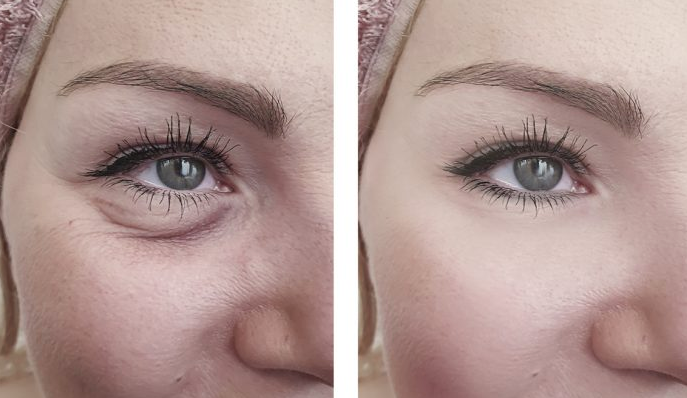Eye Bag Removal in Metro Manila
Search and Compare the Best Clinics and Doctors at the Lowest Prices for Eye Bag Removal in Metro Manila

Find the best clinics for Eye Bag Removal in Metro Manila
No clinics available
Thailand offers the best prices Worldwide
Price: $ 108

- Home
- Philippines
- Metro Manila
WHY US?
At Medijump, we're making medical easy. You can search, compare, discuss, and book your medical all in one place. We open the door to the best medical providers worldwide, saving you time and energy along the way, and it's all for FREE, no hidden fees, and no price markups guaranteed. So what are you waiting for?

Free

Best Price

Widest Selection

Risk-Free
What you need to know about Eye Bag Removal in Metro Manila

Eye bag removal, also known as blepharoplasty of the lower eyelid, is a cosmetic surgery to correct excess fat, loose skin, and wrinkles of the lower eye area. As the name suggests, the main goal of this surgery is to remove eye bags.
Your skin gradually loses elasticity and fat padding as you age. This causes your lower eyelid to appear wrinkled, puffy, and baggy. With eye bag removal, the appearance of your eye will be improved and any signs of aging will be reduced. The surgery works by removing any excess fat and skin from the under-eye area, giving it a tighter appearance. Since there are delicate structures around the under-eye, this surgery requires a precise and delicate approach.
The ideal candidate for this surgery is individuals who are physically and psychologically healthy, look tired even with adequate sleep, have under-eye bags that are present throughout the day, and do not have any health conditions such as high blood pressure and glaucoma. You also need to be 18 years of age and above to be able to undergo this procedure.
What does the Procedure Involve?
There are several surgical techniques available to remove the eye bags. The technique used depends on your goals, as well as your anatomy.
Before the procedure, your surgeon will mark your lower eyelids to help them know where to make incisions. Then, you will be given either general or local anesthetic. With general anesthesia, you will be asleep throughout the procedure, while with local anesthesia, only the affected area is numbed.
Your surgeon will begin to create incisions. The location of the incision will depend on the technique used:
-
Traditional blepharoplasty involves creating an incision just under the eyelashes. Then the fat is extracted from the lower lid and some excess skin is removed.
-
Transconjunctival blepharoplasty involves an instrument called electrocautery to create a cut inside your lower eyelid instead of the regular incision outside.
-
Pinch blepharoplasty involves extracting fat through the inside of your eyelid. Then, a “pinch” of skin from the area is removed.
-
Canthopexy is the simplest way to eliminate eye bags. This procedure involves tightening the lower eyelid and elevating its position.
How Long Should I Stay in Metro Manila?
Eye bag removal is performed as an outpatient procedure, so you can leave the hospital on the same day. However, you should plan to stay in Metro Manila for at least 7 days for initial recovery and to attend follow-up checkups as your surgeon will monitor your healing throughout these appointments. Your stitches will also be removed during one of these visits, usually within 5 to 7 days following the surgery.
What's the Recovery Time?
You should be able to return to most of your normal activities, including work, within 5-7 days following your eye bag removal surgery. However, any strenuous activities, such as working out and heavy lifting, should be avoided for around one month.
What About Aftercare?
Your surgeon will give you aftercare instructions on how to care for yourself after eye bag removal. These usually include:
-
Rest with your head elevated and use ice packs or compresses on the affected area to reduce swelling.
-
Ensure to keep your incisions clean by gently washing them. Wash your hands before you touch or go near the incisions. These will reduce the risk of infection.
-
Wear darkly tinted sunglasses to protect your eyes as your skin heals.
-
Avoid direct exposure to the sun during your recovery period.
-
Avoid any activities that may dry up your eyes, such as reading, watching television, or using your phone for too long.
-
For the first couple of days, eat soft and chewable foods.
-
Stay hydrated by drinking plenty of water.
-
Only take the medication prescribed for you. If you do need to take other drugs, such as aspirin, consult your doctor first.
-
See your doctor immediately if you experience bleeding, skin that feels hot to the touch, fever, and pain that worsens over time.
Remember, following your surgeon’s aftercare instructions is essential to achieve and maintain the optimal results.
What's the Success Rate?
Eye bag removal is safe and effective and the results look very natural.’ However, you need to be aware that all surgical procedures carry possible risks and side effects. For eye bag removal, the potential risks include double vision, bleeding, cyst on the area where the skin was sewn together, drooping upper eyelid, necrosis, excessive muscle removal, infection, skin discoloration, vision loss, and numbness.
Are there Alternatives to Eye Bag Removal?
The two main alternatives to this procedure are:
-
Dermal fillers – Dermal fillers are sometimes used to improve the look of the under-eye area. However, you need to be aware that dermal fillers are not FDA-approved to be used for under eye issues.
Laser skin resurfacing – this procedure involves the use of lasers, such as Erbium Yag lasers or CO2 to tighten the skin under the eyes. Although it is effective and less invasive, those with dark skin tones are not recommended to try this procedure as the laser can cause discoloration on highly pigmented skin.
What Should You Expect Before and After the Procedure
Before eye bag removal, you may have eye bags that make you look tired and older. For some people, having eye bags also make them feel more self-conscious and unconfident. After the procedure, your eye bags should be gone. You will look refreshed and rejuvenated and this procedure will give you a huge confidence boost.
Whilst the information presented here has been accurately sourced and verified by a medical professional for its accuracy, it is still advised to consult with your doctor before pursuing a medical treatment at one of the listed medical providers
No Time?
Tell us what you're looking for and we'll reachout to the top clinics all at once
Enquire Now

Popular Procedures in Metro Manila
Prices Start From $16

Prices Start From $28

Prices Start From $101

Prices Start From $5

Recommended Medical Centers in Metro Manila for procedures similar to Eye Bag Removal

- Interpreter services
- Translation service
- Religious facilities
- Medical records transfer
- Medical travel insurance
- Health insurance coordination
- TV in the room
- Safe in the room
- Phone in the room
- Private rooms for patients available

- Interpreter services
- Translation service
- Religious facilities
- Medical records transfer
- Medical travel insurance
- Health insurance coordination
- TV in the room
- Safe in the room
- Phone in the room
- Private rooms for patients available

- Interpreter services
- Translation service
- Religious facilities
- Medical records transfer
- Medical travel insurance
- Health insurance coordination
- TV in the room
- Safe in the room
- Phone in the room
- Private rooms for patients available

- Interpreter services
- Translation service
- Religious facilities
- Medical records transfer
- Medical travel insurance
- Health insurance coordination
- TV in the room
- Safe in the room
- Phone in the room
- Private rooms for patients available

- Interpreter services
- Translation service
- Religious facilities
- Medical records transfer
- Medical travel insurance
- Health insurance coordination
- TV in the room
- Safe in the room
- Phone in the room
- Private rooms for patients available

- Interpreter services
- Translation service
- Religious facilities
- Medical records transfer
- Medical travel insurance
- Health insurance coordination
- TV in the room
- Safe in the room
- Phone in the room
- Private rooms for patients available

- Interpreter services
- Translation service
- Religious facilities
- Medical records transfer
- Medical travel insurance
- Health insurance coordination
- TV in the room
- Safe in the room
- Phone in the room
- Private rooms for patients available

- Interpreter services
- Translation service
- Religious facilities
- Medical records transfer
- Medical travel insurance
- Health insurance coordination
- TV in the room
- Safe in the room
- Phone in the room
- Private rooms for patients available

- Interpreter services
- Translation service
- Religious facilities
- Medical records transfer
- Medical travel insurance
- Health insurance coordination
- TV in the room
- Safe in the room
- Phone in the room
- Private rooms for patients available

- Interpreter services
- Translation service
- Religious facilities
- Medical records transfer
- Medical travel insurance
- Health insurance coordination
- TV in the room
- Safe in the room
- Phone in the room
- Private rooms for patients available
Eye Bag Removal in and around Metro Manila
About Manila
Manila is the capital of the Philippines and is divided into 16 districts; it is one of the densest and populated cities of the world. Each district has its own history and cultural legacy. The city was under the rule of Spanish conquerors for almost three centuries. You can see the remains of that era in the ruins of the historical buildings. Today, the City is very modern with tall skyscrapers and modern architecture.
The Philippines is developing into one of the top countries in the world for medical tourism. Approximately 15 million people globally travel to other countries in search of quality medical care at affordable prices. Manila is a favorite destination due to the following reasons:
- It provides state-of-the-art procedures at affordable prices.
- With excellent infrastructure, the City can handle the large numbers of foreigners who visit Manila.
- The Hospital and clinic staff are very competent, friendly, and educated and have a good knowledge of English to communicate with their patients.
- The doctors are very well-qualified and hold international certifications.
- The city has a reputation in providing excellent post-surgical care by the nurses and physiotherapists.
- The Medical Industry provides many alternative therapies at some of the best spa resorts. You can combine a surgical procedure with alternative healing therapies at the same time.
Popular Areas in Manila
Manila Bay has many tourist spots and you will find many monuments that depict the Spanish occupation of the country. There are many Baroque Colonial Churches that will enable you to appreciate the artistic designs.
The National Museum of the Philippines, Bahay Chinoy, the National Art Gallery, and the Metropolitan Museum of Manila are some of the popular museums that you must visit in Manila. Rizal Park also known as Luneta is a historical urban park that is worth visiting.
There are also many organized tours that can help you get the best out of your sightseeing, for example, the Intramuros Tour, Rizal Park Tour, or the Skyscraper Gazing Tour and more.
Manila is a very modern contemporary city as the historical buildings have been replaced by modern architecture with better planning and layout and the buildings are earthquake resistant.
The city has many cultural and religious festivals throughout the year. There are plenty of shops, both big and small where you can buy branded goods at affordable prices.
Weather and Climate in Manila
The Philippines is a tropical country and in Manila, you will not experience too much temperature variations. January is the coolest month while May is the warmest month. The average temperature remains between 14°C and 38°C. The rainy season is between May and November. The rest of the months are dry. Manila is a humid city and bad weather such as Typhoons may occur during the months of June and September.
Getting around in Manila
People traveling from nearby countries such as Malaysia and Indonesia can use the City’s sea entry points. For all other passengers, the best option is to take the air route.
The Ninoy Aquino International Airport is the City’s major international airport. It has four different terminals that connect via bus transfers. If you are taking a connecting flight, remember to keep some time as a buffer, as transfers may force you to travel through the busy streets of Manila. Terminal 1 caters to International flights and Philippine Airlines uses T2 and domestic carriers and international carriers use T3 with budget carriers largely using T4.
You can take a bus from the airport to the city. Taxis have meters and you can hail a cab outside the airport. Buses and small vans or jeepneys are popular modes of transport within the city.
Manila has three light rail systems and one heavy train line. The light rail systems are the LRT-1, LRT-2, and MRT-3. You can also use the pedicabs and tricycles for shorter distances. In some areas, you can even find horse-driven carriages called calesa.
Tourist Visas in Manila
The visa process is not a very complex system as the Philippines has a visa waiver program for certain countries. All European nations, South American countries, and many others form part of this program. Citizens from these countries can stay in Manila for up to 30 days, whereas nationals from Brazil and Israel may stay in Manila for 59 days. Hong Kong, Macau, and Portugal residents can stay for 14 days without a visa. Tourists belonging to other countries need to apply for a visa to enter the Philippines, in the consulate in their respective countries.
You must also have a valid return ticket. Passport must also be valid for at least six months and beyond to stay in the country. Visa-exempt people may extend their stay by one or two months after which they will have to apply for a visa.
Additional Information
- The currency of the Philippines is Peso (symbol: ₱). It is strong in the world market and the usual exchange rate is 1 Dollar equals 50 Pesos. Dollars are easy to exchange compared to other currencies.
- Credit cards are acceptable in almost every place. The city also has many ATMs from where you can withdraw money without difficulty. However, ATMs will charge you a minimal exchange fee on foreign cards.
- Bargaining and negotiating are acceptable in most places and it can get you better deals.
- Restaurants may add a service charge of up to 10%. You can pay a cash tip of 5 to 10 %. People often round off the taxi fare.
- Manila is a city full of people who speak English proficiently. Filipino and English are the two official languages. Filipino is a variety of Tagalog, Austronesian languages.
- Hindu, Muslim, Buddhism, and Christian religions have left their mark on the Philippines at different periods. Today, a majority of the population is Roman Catholic.
- There are many public holidays in Manila. Some of the important ones are Christmas Eve, Christmas, Eid al-Fitr (Ramadan), Labor Day, New Year, and Good Friday, etc. The Independence Day falls on June 12th and Manila Day on 24th June.
Popular Searches
- Plastic Surgery in Thailand
- Dental Implants in Thailand
- Hair Transplant in Thailand
- Breast Augmentation Thailand
- Gastric Sleeve in Thailand
- Gender Reassignment Surgery in Thailand
- Laser Hair Removal in Bangkok
- Botox in Bangkok
- Dermatology in Bangkok
- Breast Augmentation in Bangkok
- Coolsculpting in Bangkok
- Veneers in Turkey
- Hair Transplant in Turkey
- Rhinoplasty in Turkey
- Stem Cell Therapy in Mexico
- Rhinoplasty in Mexico
- Liposuction in Mexico
- Coolsculpting in Tijuana
- Rhinoplasty in Korea
- Scar Removal in Korea
- Gastric Sleeve in Turkey
- Bone Marrow Transplant in India
- Invisalign in Malaysia
- Plastic Surgery in the Dominican Republic
- Tummy Tuck in the Dominican Republic
- Plastic and Cosmetic Surgery in Poland
- Rhinoplasty in Poland
- Hair Implant in Poland
- Dental Implants in Poland
- IVF in Turkey